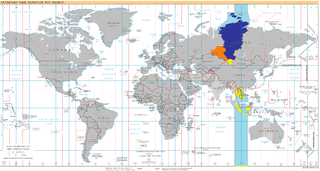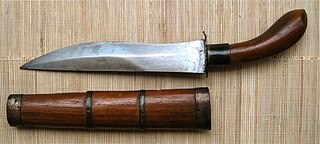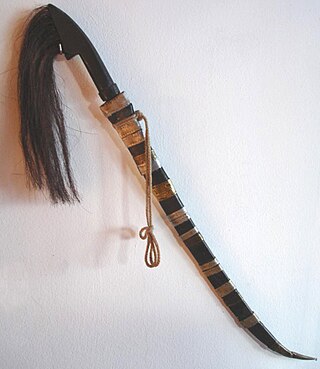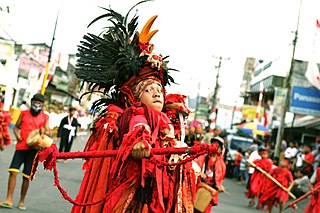
The East Indies is a term used in historical narratives of the Age of Discovery. The Indies refers to various lands in the East or the Eastern hemisphere, particularly the islands and mainlands found in and around the Indian Ocean by Portuguese explorers, soon after the Cape route was discovered. Nowadays, this term is broadly used to refer to the Malay Archipelago, which today comprises the Philippine Archipelago, Indonesian Archipelago, Borneo, and New Guinea. Historically, the term was used in the Age of Discovery to refer to the coasts of the landmasses comprising the Indian subcontinent and the Indochinese Peninsula along with the Malay Archipelago.

The kampilan is a type of single-edged sword, traditionally used by various ethnic groups in the Philippine archipelago. It has a distinct profile, with the tapered blade being much broader and thinner at the point than at its base, sometimes with a protruding spikelet along the flat side of the tip. The design of the pommel varies between ethnic groups, but it usually depicts either a buaya (crocodile), a bakunawa, a kalaw (hornbill), or a kakatua (cockatoo)..

UTC+08:00 is an identifier for a time offset from UTC of +08:00.

UTC+09:00 is an identifier for a time offset from UTC of +09:00.

Jonava District Municipality is one of 60 municipalities in Lithuania.

UTC+07:00 is an identifier for a time offset from UTC of +07:00. In ISO 8601 the associated time would be written as 2023-09-22T13:23:35+07:00. It is 7 hours ahead of UTC, meaning that when the time in UTC areas is midnight (00:00), the time in UTC+07:00 areas would be 7:00 in the morning.

Pencak silat is an umbrella term for a class of related Indonesian martial arts. In neighbouring countries, the term usually refers to professional competitive silat. It is a full-body fighting form incorporating strikes, grappling, and throwing in addition to weaponry. Every part of the body is used and subject to attack. Pencak silat was practiced not only for physical defense but also for psychological ends. There are hundreds of different pencak silat styles and schools which tend to focus either on strikes, joint manipulation, weaponry, or some combination thereof.

Ileana Silai is a retired Romanian middle-distance runner. She competed in the 800 m at the 1968, 1972 and 1976 Olympics and in the 1500 m at the 1976 and 1980 Olympics. She won a silver over 800 m in 1968. At the European indoor championships she won silver medals in the 800 metres in 1971 and 1972 and a gold in the 1500 m in 1978.

The Alune people are one of the long-established ethnic groups of Seram Island, Indonesia. They number about 21,300 and live in 27 villages of the western-central area of the island. Like the Wemale, they originated in a common group called Patasiwa.

The gunong is a knife from Mindanao and the Visayas islands of the Philippines. In ancient past, it was called bunong by the Tagalog people. It is essentially a diminutive form of the larger kalis or kris. The gunong serves both as a utility knife and as a thrusting weapon used for close quarter fighting—usually as a last defense. It is most often associated with the Maranao, among whom the gunong was traditionally carried by both sexes, although it exists in other cultures throughout Mindanao and the Visayas. The weapon is generally tucked into the back of a waist sash.

Šilai is a village in Jonava district municipality, in Kaunas County, in central Lithuania. According to the 2011 Lithuania census, the village has a population of 347 people. Administrative centre of Šilai Eldership.

The surik is a traditional sword native to the island of Timor or Nusa Tenggara in wider extent, as well as Sumatra. The first coat of arms of East Timor depicted crossed suriks.

Niabor is a curved sword from Borneo, a characteristic weapon of the Sea-Dayaks.

The Pandat is the war sword of the Dayak people of northwest Borneo and is never used as a tool. On October 18, 2016, this weapon was featured in season 3 episode 9 of the American bladesmithing competition series Forged in Fire.

Balato is a sword that originates from Nias, an island off the west coast of North Sumatra, Indonesia.

Gari is a sword that originates from Nias, an island off the west coast of North Sumatra, Indonesia. It is a term used for a type of sword found only in North Nias.

Baluse or Baloese is a traditional shield of the Nias people originating from Nias, an island off the west coast of North Sumatra, Indonesia. Baluse in the Northern Nias is somewhat smaller than those of the rest of the island.

Kabasaran is a traditional Minahasan martial art and war dance from North Sulawesi in Indonesia. It is performed by several men clad in red costumes, wielding a sword with a shield or a spear. The dancers are called kawasalan, which implies imitating like a pair of fighter cocks. the word kabasaran is derived from kawasalan.

A luwuk is a type of short sword from the island of Java. This sword is found mostly in East Java and Central Java.

Šilai Eldership is a Lithuanian eldership, located in an eastern part of Jonava District Municipality. As of 2020, administrative centre and largest settlement within eldership was Šilai.























